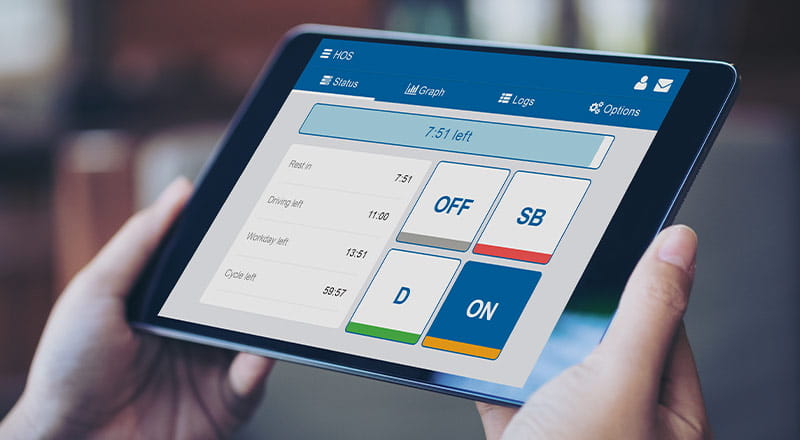The Federal Motor Carrier Safety Administration (FMCSA), a stand-alone Department of Transportation (DOT) agency, has developed a detailed set of rules designed to keep roads safe by ensuring drivers limit the long hours they spend behind the wheel. These Hours of Service regulations apply to all DOT regulated commercial motor vehicle operators in the US.
It’s important to note that the ELD compliance mandate is an extension of the Hours of Service rules, attempting to create an easier system for tracking and manage records of duty status (RODS). As of December 2017, all vehicles subject to the ELD mandate must record Hours of Service electronically to maintain DOT compliance.
Below is an overview of the DOT Hours of Service (HOS) regulations and exemptions.
Hours of Service regulations
For property-driving commercial motor vehicles (CMVs), here are some of the most important HOS rules to remember, as outlined by the FMSCA:
- 14-Hour Shift Limit: CDL (Commercial Driver’s License) drivers may not drive beyond the 14th consecutive hour after coming on duty, but can resume driving after 10 consecutive, off-duty hours.
- 11-Hour Driving Limit: Drivers may drive a maximum of 11 hours within the 14-hour window, after 10 consecutive, off-duty hours.
- 30-Minute Breaks: Drivers may not drive if 8 hours have passed since the last off-duty period of at least 30 consecutive minutes. Operators can perform non-driving tasks after 8 hours without a break, but cannot drive.
- 60/70-Hour Limit: Drivers may not drive after 60/70 hours on duty in 7/8 consecutive days. Operators can restart a 7/8 consecutive day period after taking 34 or more consecutive, off-duty hours.
It’s important to remember these rules, and how to figure out a way to track them. More to come on HOS tracking solutions later…keep reading.
DOT Hours of Service exemptions
Under certain conditions, commercial drivers are exempt from the HOS rules outlined above. Here are four of the most commonly used DOT Hours of Service exemptions:
1. Short-haul exemption
If drivers operate within a 150 air-mile radius of their work location and do not exceed the 14-hour shift limit, they are exempt. This is most often used by drivers who complete daily deliveries or only travel short distances.
2. 150 air-mile radius exemption
Non-CDL drivers who operate within a 150 air-mile (a nautical mile that measures distance in a straight line) radius of their daily starting location, end their shift at the same location, and do not drive after the 14th hour of coming on duty in a period of 7 consecutive days do not need to complete an ELD log and are exempt from the 30-minute break rule.
3. 8-Day RODS exemption
Drivers who maintain a RODS (Record of Duty Status) for fewer than 8 days within a 30-day period are exempt from completing ELDs. This applies to drivers who meet all requirements of the short-haul exemption but sometimes drive outside of the designated radius.
4. Adverse driving conditions exemption
Drivers may extend the 11-hour maximum driving limit and 14-hour driving window by up to 2 hours when encountering adverse driving conditions, such as weather changes or road closures. The exemption is only applicable if the adverse conditions could not have been known before the driver started driving.
Additional new DOT Hours of Service exemptions
The FMCSA has recently revised the HOS regulations to add flexibility to the rules and simplify fleet management. In addition to the above exemptions, these changes also went into effect on September 29, 2020:
- Satisfy the 30-minute break rule by using on-duty, not driving status, rather than off-duty status.
- Split the required 10 off-duty hours into two periods: at least 7 consecutive hours in the sleeper berth and at least 2 consecutive hours either off-duty or in the sleeper berth. Neither period would count against the driver’s 14-hour driving window.
- Allow one off-duty break of 30 minutes to 3 hours that would pause a driver’s 14-hour window. The driver must take 10 consecutive, off-duty hours at the end of their shift.
DOT Hours of Service solutions
If you’re worried about navigating FMCSA’s regulations and ensuring you’re taking the right exemptions, you’re not alone. Lytx can help you easily adhere to DOT regulations with a service that’s built to track HOS.
However your company currently tracks hours—from paper logs to ELDs—we can consolidate your RODS into a single, online system. Stay compliant with the ELD mandate by using Lytx® Compliance Services to audit all documents, in any format. You’ll have access to customized dashboards and reporting to help you identify compliance risks. Everything you need to help you meet DOT Hours of Service regulations (and qualify for exemptions) will be in one platform.
